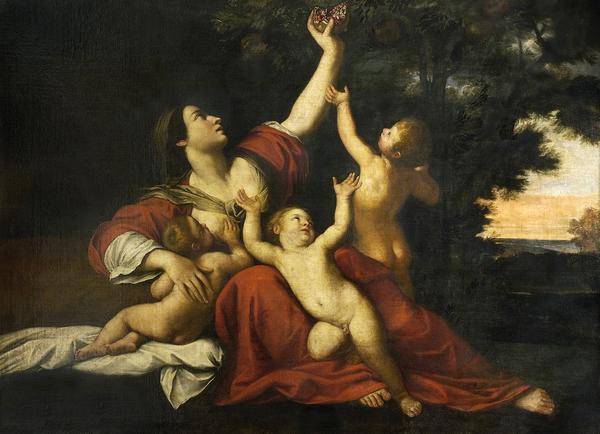The old name of the picture under which it was once mentioned in the collection of Empress Josephine, the first wife of Napoleon Bonaparte, as Nature through the image of a woman feeding her children. The picture was painted by the renowned Italian artist Marcantonio Franceschini of the second half of the 17th century. He gained strong academic education in Bologna and continued traditions of the famous master of classic line Francesco Albani. For a long time the name Philoprogeneity, maternity love to children, was mentioned on the label.
The genuine name of the picture is expressed in the name Allegory of Christian Mercy, the name the picture appeared with in the Imperial Hermitage. This allegory reflects a Christian concept about the principal of all virtues, love and mercy. Since Antiquity virtues and vices were embodied in human figures.
The principal Christian virtues are faith, hope and love. Apostle Paul in the First Epistle to the Corinthians extols the greatest of the divine gifts, that is self-sacrificing love similar and like the love of Jesus himself. He writes: ‘Love is patient, love is kind and is not jealous; love does not brag and is not arrogant, does not act unbecomingly; it does not seek its own, is not provoked, does not take into account a wrong suffered, does not rejoice in unrighteousness but rejoices with the truth; bears all things, believes all things, hopes all things, endures all things. Love never fails. But if there are gifts in prophecy, they will be done away; if there are tongues, they will cease; if there is knowledge, it will be done away (…). But now faith, hope, love, abide these three; but the greatest of these is love. The painting Allegory of Mercy is an example of classic composition, clear, harmonic and majestic.
A regular triangle with two equal sides underlies the painting. This is a form of composition unveiled as far back as during the times of Leonardo de Vinci. It creates the impression of perfect balance and stability. The woman surrounded by the children constituting the Allegory of mercy is placed in the shades of pomegranate tree. In her raised hand is a pomegranate fruit, Christian symbol of Resurrection.
A multitude of kernels contained under a tough peel made it also a symbol of unification of many people under a single source, a Church or a Secular ruler. Equally symbolic is a landscape in the right part of the picture with a low sky-line and a warm evening lighting. It evokes a feeling of quietness and calmness.
However, the woman and the children are elucidated from a different source. This is one of the features of classism. The author of the picture cares more about the artistic effect rather than the credibility. Large, clearly discernible forms of the picture remind of the fact that its author often had to decorate the ceilings and walls and to bring precision and visibility to the image.


